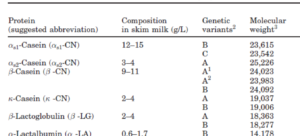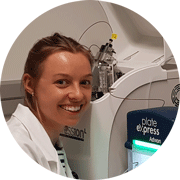Federico II University Medical School of Naples, University of Naples “Federico II”
Abstract
Vitamin D deficiency and obesity are two public health problems extensively exacerbated over the last years. Among the several mechanisms proposed to account for the complex interplay between vitamin D and obesity, one that has gained particular attention is related to the emerging role of obesity-related changes in gut microbiota and gut-derived metabolites, such as Trimethylamine-N-oxide (TMAO). Vitamin D deficiency and high circulating TMAO levels are associated with body weight and the severity of non-alcoholic fatty liver disease (NAFLD). Considering the link of obesity with vitamin D on the one hand and obesity with TMAO on the other hand, and the central role of the liver in both the vitamin D and TMAO metabolism, the aim of this cross-sectional observational study was first, to confirm the possible inverse association between vitamin D and TMAO across different body mass index (BMI) classes and second, to investigate if this association could be influenced by the presence of NAFLD. One hundred and four adult subjects (50 males and 54 females; 35.38 ± 7.49 years) were enrolled. The fatty liver index (FLI) was used as a proxy for the diagnosis of NAFLD. Vitamin D deficiency was found in 65 participants (62.5%), while 33 subjects (31.7%) had insufficient levels, and the remaining subjects had sufficient levels of vitamin D. Subjects with both vitamin D deficiency and FLI-NAFLD had the highest TMAO levels (p < 0.001). By stratifying the sample population according to the BMI classes, vitamin D levels decreased significantly along with the increase of plasma TMAO concentrations, with the lowest vitamin D levels and highest TMAO, respectively, in class III obesity. Vitamin D levels showed significant opposite associations with circulating levels of TMAO (r = −0.588, p < 0.001), but this association was no longer significant after the adjustment for FLI values. The highest values of TMAO were significantly associated with the severity of obesity (OR 7.92; p < 0.001), deficiency of vitamin D (OR 1.62; p< 0.001), and FLI-NAFLD (OR 3.79; p < 0.001). The most sensitive and specific cut-off for vitamin D to predict the circulating levels of TMAO was ≤19.83 ng/mL (p < 0.001). In conclusion, our study suggests that high TMAO levels are associated with vitamin D deficiency and NAFLD. Further studies are required to investigate if there is a causality link or whether all of them are simply the consequence of obesity.
Analysis was performed by LC/MS using the Advion expression® Compact Mass Spectrometer (CMS).
In this application note, the Advion Interchim Scientific® AVANT™ UHPLC/CMS system is used to analyze casein proteins in whole milk extract to separate and detect β-casein-B, -A1, and -A2, as well as K-casein and αs1-casein variants. This method is also suitable for a quick, relative quantitation of the β-casein-B, -A1, and -A2 variants in standards of β-casein.

Provides simple, automated MS analysis in seconds, directly from TLC plates
The Plate Express® is a device that provides a simple, automated means of obtaining mass spectra directly from TLC plates, creating a technique known as TLC/MS. Combined with Advion Interchim Scientific’s expression® compact mass spectrometer (CMS) this becomes TLC/CMS. Using this technique, chemists can quickly and confidently identify products even in complex mixtures without additional sample preparation.
- Identify spots in <1 minute
- Avoid the risk of overloading the mass spectrometer – TLC spots contain the ideal amount of sample for mass spectrometry
- Software controlled – spectra obtained within a few mouse clicks
- Simplify the process of obtaining spectra – ideal for multi-user labs
Providing simple, high-performance, LC/CMS with the expression® CMS
Modular, stackable design, with many options provides custom solutions for both HPLC and UHPLC needs. From the simplest manual injection HPLC to a fully automated, streamlined UHPLC system and everything in-between, the Avant series can be configured to fit your analytical requirements and your budget.
The AVANT® (U)HPLC series is the latest in Advion’s innovative line of sample inlet devices for the expression® CMS which include:
- Plate Express® for automated mass assays from TLC plates
- The ASAP® direct analysis probe for solid, liquid and even air sensitive samples using iASAP
- vAPCI for analysis of volatile organic compounds (VOCs) from head spaces, breath, and other gas samples.
- Flow chemistry interfaces
All these techniques can be simply, simultaneously, interfaced with the CMS so that the chemist can move quickly and effortlessly between workflows.
For One-Touch Mass Analysis of Solids, Liquids, Surfaces and Fibers with the expression® CMS
The Touch Express™ Open Port Sampling Interface (OPSI), is designed for simple sampling of surfaces, solids, liquids and sample preparation tips and fibers. The novel ambient sampling technique was developed by Gary Van Berkel and Vilmos Kertesz, of Oak Ridge National Laboratory.
Paired with the electrospray ion source of the expression® Compact Mass Spectrometer, the solvent forms a meniscus at the open port before being drawn down the inner path into the electrospray ion source of the mass spectrometer under the Venturi effect of the nebulization gas. Any soluble sample touching the port is analyzed by the mass spectrometer in just seconds. Touch Express™ OPSI offers a fast assay bench-top solution for solid, liquids, and surfaces in a small-footprint, easy-to-use system.
Introduction
Electrospray mass spectrometry (ESI-MS) is a versatile analytical tool for biomolecular protein analysis and proteomics. One important area is to study protein structure and composition in which peptides and proteins can be ionized with multiple charges via electrospray ionization. Based on the charge envelope, the molecular weight can be easily determined using manual or automated deconvolution.
Touch Express™ is a new sampling device for mass spectrometry analysis using a technique developed by Gary Van Berkel and Vilmos Kertesz of Oak Ridge National Laboratory1 — the Open Port Sample Interface (OPSI). The OPSI incorporates an open port of continuous, low-volume solvent, flowing directly into the electrospray ion source of the mass spectrometer. Analysis is carried out by simply touching a sample to this port. This fast, versatile sample inlet paired with the expression® Compact Mass Spectrometer (CMS) provides simple molecular weight determination of surfaces, solids and liquids.
Touch Express™ OPSI is a direct analysis method for peptide and protein identification, introduced into the Advion expression® CMS and ionized via the ESI source. The sample can be analyzed < 1 min, and the continuous flow of solvent by OPSI also saves chemists more time for their compound analysis without contamination issues when one system is shared by multiple users or when running back-to-back samples. The deconvolution feature implemented in Advion Data Express software can easily help chemist to predict uncharged mass of their target peptides or proteins based on their charge envelope. Three compounds: BSA, myoglobin (horse) and lysozyme, are used for demonstration.

Q: WHAT IS THE FOCUS OF YOUR LAB’S RESEARCH?
A: Our laboratory focuses on the development of small molecules with functions that are fulfilled in nature by large macromolecules. We utilize the power of organic synthesis to access functionalities that nature might not have in the repertoire of building blocks. The focus is both on practical applications and an understanding of the properties on the molecular level. This scope includes the development of bioinspired asymmetric catalysts and functionalisable collagen, molecular scaffolds for applications in supramolecular and biological chemistry (e.g., cell-penetrating peptides and tumor targeting) and the controlled formation of metal nanoparticles.
Q: WHAT WAS YOUR PREVIOUS WORKFLOW OR CHALLENGES?
A: For the synthesis of building blocks and target molecules it is important to efficiently analyze and confirm their chemical structures. We routinely do this by, e.g., NMR spectroscopic analysis of the isolated and purified products. This involves the analysis of small molecules in our asymmetric catalysis projects as well as molecules with molecular weights of up to 2000 Da in our chemical biology and materials science projects. In particular for new reactions, fast and straightforward analysis methods for the newly formed compounds are important but challenging at the same time.
Q: WHY DID YOU INCORPORATE THE EXPRESSION® CMS INTO YOUR LABORATORY?
A: The expression® CMS allows us to efficiently analyze the mass of newly formed compounds in (almost) real time. We particularly value that the instrument allows us to monitor the reaction progress of crude mixtures. Separated on a TLC, products and potential side products can be identified, which results in an optimized and faster down-stream-processing, e.g. column chromatography, and only desired products are isolated on a preparative scale. Furthermore, the ASAP mode is very helpful and extremely fast, when looking for expected product masses, e.g. in the fractions of preparative HPLC separations – just dip it in and measure the MS… it takes 30 seconds per fraction. The possibility to easily switch between the ionization modes ESI and APCI as well to measure MS spectra in positive and negative mode in parallel is very helpful for a fast and reliable analysis.
Q: WHO WOULD YOU RECOMMEND TO PURCHASE THE EXPRESSION® CMS?
A: We recommend the expression® CMS in combination with the TLC-Reader Plate Express™ to any group working in the field of synthetic organic chemistry. The reliable and fast identification of molecules is extremely helpful to monitor reactions, to identify the desired products and potential side products, and to simplify downstream processing.
The Touch Express™ Open Port Sampling Interface (OPSI), is designed for simple sampling of solids, liquids and sample preparation tips and fibers. The novel ambient sampling technique was developed by Gary Van Berkel and Vilmos Kertesz, of Oak Ridge National Laboratory.
Paired with the electrospray ion source of the expression® Compact Mass Spectrometer, the product incorporates a low volume, open port of continuously swept solvent, flowing directly into the electrospray ion source of the mass spectrometer.
During this webinar you will:
- Learn how any soluble material touching the port is analyzed by the expression® Compact Mass Spectrometer in just seconds.
- Learn how the sample technique eliminates sample preparation and provides zero carry over.
- Find fast analysis methods for solids, liquids and sample preparation tips and fibers.
Touch Express™ is a new sampling device for mass spec analysis using a technique developed by Gary Van Berkel and Vilmos Kertesz of Oak Ridge National Laboratory – the Open Port Sample Interface (OPSI). This fast, versatile sample inlet paired with the expression® Compact Mass Spectrometer (CMS) provides simple molecular weight determination of surfaces, solids and liquids in < 30s.
The Touch Express™ Open Port Sampling Interface (OPSI), is designed for simple sampling of solids, liquids and sample preparation tips and fibers. The novel ambient sampling technique was developed by Gary Van Berkel and Vilmos Kertesz, of Oak Ridge National Laboratory.
Paired with the electrospray ion source of the expression® Compact Mass Spectrometer, the product incorporates a low volume, open port of continuously swept solvent, flowing directly into the electrospray ion source of the mass spectrometer.


